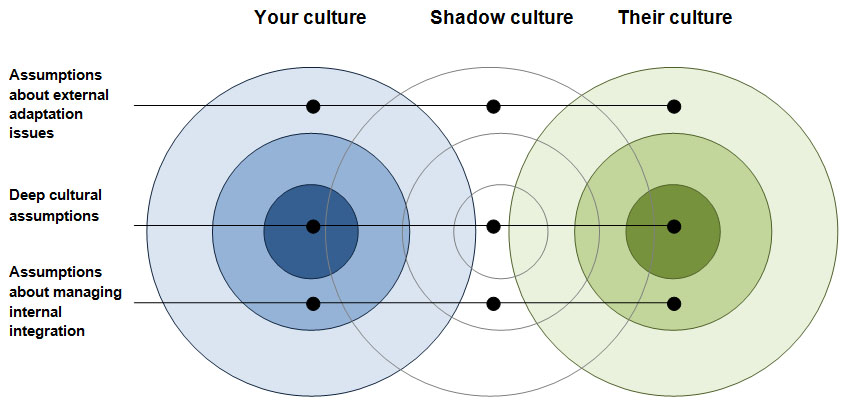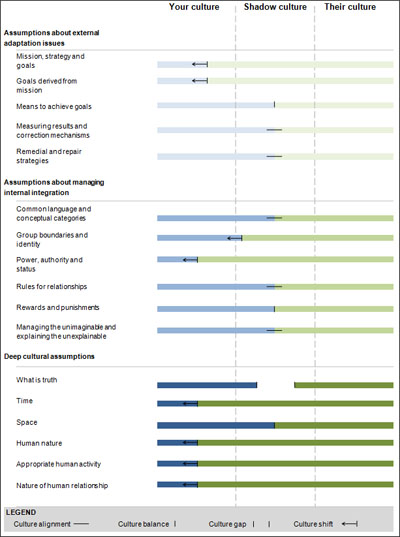Embrace your organisational shadow culture
We use words like “partnership” and “integrated” when we talk about client and supplier relationships. There is a dark side to this kind of language, however. Seventy-five per cent of mergers and acquisitions fail or result in reduced profits, high turnover, and low performance for one if not all parties. The primary cause is culture conflict, one that can be mitigated by bringing your shadow culture into the light.

Operating in the shadows
The concept of a subversive shadow culture has been applied to organisations before. Linda Holbeche identifies it as the informal way of doing things, while Christopher Dawson notes a distinction between what he calls an Ideal shadow culture and a Required shadow culture. These approaches to shadow culture borrow on the concept of the Johari Window, which depicts four quadrants of what is known and unknown to others and ourselves.
The concept of a shadow culture can also apply towards the boundary between a supplier and a client. The shadow culture makes assumptions that are reflective of but distinct from the culture within each organisation. The degree of conflict within that shadow culture depends upon the extent to which the assumptions align with the culture in each organisation.

Shine light on your shadow
Shadow cultures are not bad, but they do need to be understood within the context of the culture of each organisation. Using Edgar Schein’s culture model discussed previously, we can identify four possible scenarios for each assumption:
- The shadow culture can represent cultural alignment, where the assumptions of each group are similar.
- There can also be a cultural balance, where assumption differences in each group are maintained in a collaborative and synergistic environment.
- Conversely, differences can produce a culture gap where the differences are not resolved but the assumption is not critical enough to common objectives to be addressed.
- Finally, a culture shift can occur where the culture of the dominant party is projected onto the other party.
We define our shadow cultures by assessing each assumption using a series of questions, such as the ones below. This process can be done with each organisation involved, and ideally facilitated by an unbiased third party to obtain accurate results.
- Is the mission or goals of the other party overriding the other?
- Are you all on the same page as to how to achieve your common goals?
- Do you both measure outcomes in the same way? Do you measure at all?
- What are your approaches to fixing things when they break? Panic or process?
- Have you developed a common language distinct from either party? What do phrases like “We have an issue” or “That was successful” mean?
- Do you have an agreed method of respecting boundaries and establishing each other’s identity in and out of the relationship? Are there out of hours requirements? Do you get together for family dinners?
- How is power and authority defined? Are there agreed escalation points?
- How do you maintain relationships between each other? Handshackes? Phone calls? Combined meals?
- How do you reward and punish each other? Gifts? Withholding work or payments?
- What do you do when something cannot be explained? Blame? Justify? Ignore?
- Do you all agree on how to find out what is true? Is it because the CEO says, by agreed consensus, or by what is proven as fact?
- Does one organisation process activities sequentially through time while the other does everything at once?
- How do you each treat space? Open or closed office layouts? Large board room meetings or intimate office settings?
- Is human nature all about competition and winning, or developing the individual?
- Is activity based on taking charge of the situation, being reactive to the environment, or some combination of each?
- Does everyone understand their place in the relationship, their identity and role and how participation in the group satisfies that identify?

Embrace your shadow
A few important aspects of shadow cultures need to be considered.
- Our shadow cultures are not inherently good or bad. The impact is measured by the extent to which the shadow culture detracts or enhances overall outcomes.
- Shadow cultures bring innovation. Shadow culture can have a value greater than the contribution of the individual culture. This is called synergy, with the shadow culture introducing innovation back into each organisation.
- Rely on the strengths of your shadow culture. Just as opposites attract, disparities in assumptions can work for the best if each party learns to apply their strengths towards the other’s weaknesses.
- Get familiar with your shadow. We are afraid of our shadows only when they surprise us. Bring the shadow culture into the light to legitimise what everyone knows is happening.
Hopefully this provides you with some tools to acknowledge, embrace and develop shadow cultures within your own organisation.

2 thoughts on “Embrace your organisational shadow culture”
Comments are closed.